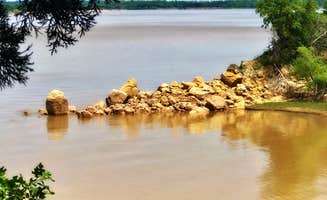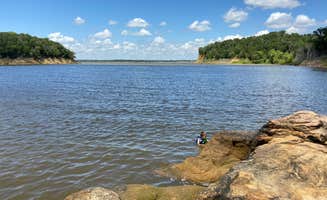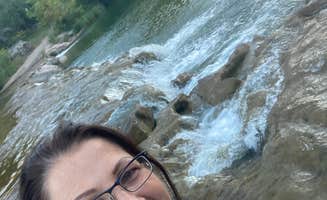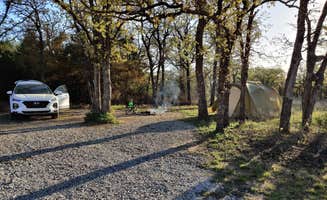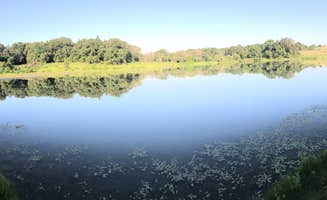Dispersed camping areas near Marietta, Oklahoma provide primitive outdoor experiences in the rolling grasslands and river valleys of southern Oklahoma and northern Texas. The semi-arid climate typically features hot summers with temperatures frequently exceeding 95°F and mild winters, though weather patterns can shift dramatically with frontal systems moving through the region. Most camping areas sit at elevations between 700-900 feet, with terrain characterized by oak savanna, riparian corridors, and mixed-grass prairie habitats.
What to do
Swimming and wading: Natural swimming holes at Blue River Camp offer relief during hot summer months. "There's a really neat little spot south of the dam with a rope swing," notes Carrie T., who visited in August 2024. The clear water provides refreshing opportunities, especially on weekdays when visitor numbers drop significantly.
Wildlife viewing: Early mornings and dusk at LBJ National Grasslands Forest Road 904 reward patient observers. "See deer, armadillos, hogs, and birds," recommends Tim O., adding that spots are "very well spaced out" providing privacy for wildlife observation. The grasslands ecosystem supports diverse species adapted to the semi-arid conditions.
Hiking and backpacking: Cross Timbers Trail along Lake Texoma offers technical terrain unusual for the region. Kelly G. describes Eagle's Roost Campsite: "It's way up on a wooded peninsula along a spur that overlooks the lake. Birds flock over and it's far enough away from the freeway that it's quiet." The 14-mile point-to-point trail system provides good training for more challenging terrain elsewhere.
What campers like
Solitude and remoteness: The widely spaced sites at dispersed camping areas provide genuine privacy. "Remote, quiet, simple beauty. Easy access, cool area. Worth checking out for a low profile weekender or hike," reports Christopher L. about his April visit to Forest Road 904. Several reviews mention the therapeutic quiet as a primary draw to the region.
Night sky viewing: Clear skies away from urban light pollution create exceptional stargazing opportunities. Michelle T. at Lyndon B. Johnson National Grassland suggests: "If you are there in the right time of the year, stay out late and turn off your lights - you'll get a night surprise." The grassland's open expanses provide unobstructed horizon views ideal for astronomical observation.
Scenic landscapes: The rolling terrain creates distinctive viewpoints. "We did find a nice pull-through, overlooking the valley to the NW," notes Ray & Terri F., adding "We had the whole area to our selves on Sunday and Monday." Michele A. describes finding "a pretty great vista view from which the spectacular sunset was just a great bonus" at the grasslands.
What you should know
Access and permits: Entry requirements vary significantly between areas. At Blue River Camp, "To enter the grounds you need a hunting/fishing license or a 3day wildlife conservation passport. The passport is for any activity on the grounds, excluding hunting or fishing and they are $51 currently," explains lora, highlighting costs visitors must account for when planning trips.
Road conditions: Many sites require careful driving on unpaved roads. Michelle T. cautions about 5 Mile Camp: "I would NOT recommend taking any kind of trailer or motorhome down these roads and to this spot." Forest service roads can deteriorate after rainfall, making high-clearance vehicles necessary for some locations.
Environmental stewardship: Pack out all waste as facilities are minimal. "The only downside was the amount of trash that people had left," reports Andi P. about Blue River Camp. Corey C. similarly notes finding a site with "beautiful views, but previous visitors left behind debris - if you use, please practice pack in/out principals!"
Tips for camping with families
Water activities: River access provides natural entertainment for children. Nancy describes Blue River Camp simply as "Gorgeous" with multiple swimming areas suitable for families. The natural rock formations along waterways create shallow wading areas appropriate for supervised children.
Campsite selection: Scout locations before committing to specific sites. Ronald S. advises: "Remote dispersed. Great camping for north central Texas. The sites are a good distance between them. You can drive along the roads and look for them. We spotted 22 sites, there may be more." This spacing allows families privacy while giving children space to explore.
Safety considerations: Prepare for wildlife encounters. Griffin K. notes the LBJ grasslands are "Very remote so bring what you need. Very quiet you won't hear anyone besides the wildlife at night!" Cattle frequently graze through some camping areas, requiring proper food storage and situational awareness with children.
Tips from RVers
Site accessibility: Large rigs require careful planning at rustic sites. Ray & Terri F. suggest: "If you have a tow vehicle, drop it just inside the gate, leave your RV and go scope out a suitable campsite, as turning around with a large rig is only practical in a couple of locations." They successfully parked their 36' Class A on Forest Road 904 after reconnaissance.
Wind exposure: Elevated sites experience stronger winds. Jennifer N. shares: "This was my first experience boondocking. Absolutely loved the location! Not too far from town if you need something... It did get rather windy but I was on top of the hill. Live and learn." Positioning RVs with wind direction in mind improves comfort and reduces fuel consumption from heating/cooling.
Water management: No potable water exists at most sites. Mesha P. notes that while some campgrounds have water sources, "it's not potable so pack water in or bring a filtration system." Jennifer adds there is "a water dispensary in Decatur which is nice and convenient" for refilling RV tanks when camping at LBJ Grasslands.


